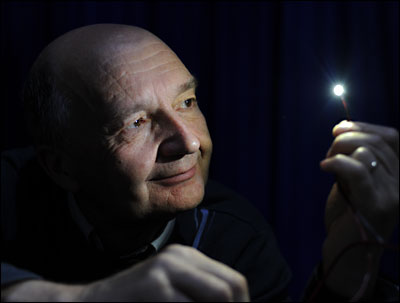
Wireless Optical Networks Eyed for Vehicles
CONVENTRY, England, Sept. 4, 2012 — LED-based wireless optical networks in vehicles could significantly cut the weight of wiring under the hood, not only saving on fuel, but also allowing passengers to tap into visible or infrared spectrum bands in overhead lighting to watch movies or play music.

Replacing copper wiring with LED-based wireless networks could significantly cut a vehicle's weight, saving fuel, say engineers at the University of Warwick. Such systems would also benefit passengers by giving them access to an unlimited and unregulated spectrum for their smartphones and other computer devices. (Photo: iStockphoto)
Radio frequency signals are currently used for smartphones, for hands-free headsets for the driver and passengers, and for multimedia-related applications such tablet PCs, but RF communication suffers from a congested bandwidth. In contrast, wireless systems benefit from an unlimited and unregulated spectrum.
Although optical wireless has been explored for some time in aviation, scientists in the University of Warwick's Department of Engineering are exploring its use in private vehicles. It can be used to communicate between parts inside a car's engine compartment, such as between temperature sensors and the engine management system, or between the brake and speed-control systems.
Optical wireless can simply use a basic LED, such as those used in flashlights, to send data. In situations where it’s best for the beam to be invisible, infrared light can be used instead. It can be installed in the overhead lights for in-car entertainment.
The major advantage of optical wireless is the weight of wiring it can remove from cars, translating into significant fuel savings over the lifetime of a vehicle, the researchers say. But it also reduces manufacturing costs, as LED and infrared light sources are not expensive to make, and it cuts back on the expense of maintaining and repairing wires.

The University of Warwick's Roger Green, who is working to create LED-based optical wireless networks. Photo: University of Warwick)
Combined, all these factors spell significant advantages over the current systems for in-car data, which, in the engine, are generally copper wire-based or carbon fiber systems.
"Optical wireless is relatively unknown at the moment. But it's not hard to imagine a day when passengers can watch TV streamed through a beam coming from their overhead light, or when parts of the engine can 'talk' to each other without wires," said UW professor Roger Green. "We believe that this technology is poised to come into its own."
Other benefits of the technology include its lack of electromagnetic interference, he said.
University of Warwick engineers presented their work into optical wireless and its use in cars at the International Conference on Transparent Optical Networks held in July at the university.
For more information, visit: www2.warwick.ac.uk
Published: September 2012